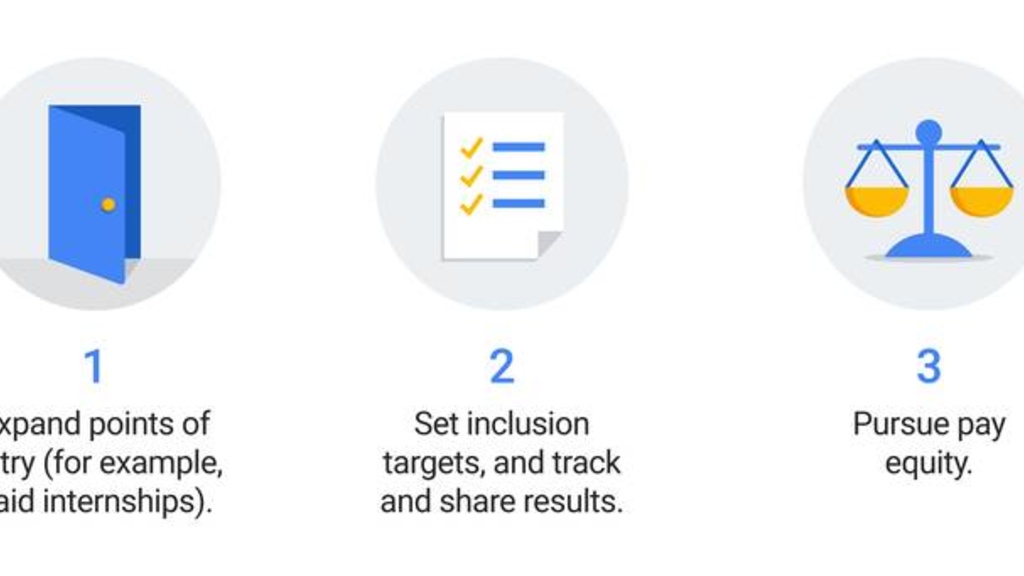Inclusive recruitment and hiring practices consider more than seeking candidates of different races or genders.
Inclusive hiring takes into account the needs of candidates with cognitive differences, abilities, educational backgrounds, socioeconomic status, and more. By broadening your hiring practices to be inclusive of all, your company can attract a wider pool of candidates and increase your chances of finding the right fit — someone who can do the job well and help the company grow.

The power of difference:
Professor David Slocum, academic director at Rare, a Google platform that enables underrepresented talent to thrive and businesses to drive more inclusive cultures, shares practical tips for hiring and retaining diverse teams, and creating more relevant campaigns in the process.
8 Inclusive Hiring Practices You Need to Adopt Today
The language used in job descriptions can play a big role in inclusive hiring. Research shows that words like “strong” and “competitive” are perceived as male-specific and can deter female candidates from applying. Likewise, terms like “sensitive” dissuade male candidates from submitting an application.
The complexity of your job description also plays a role. Use short, simple sentences that emphasize the must-have skills for a candidate, rather than an exhaustive list of qualifications. Many companies inadvertently discourage diverse talent from applying by setting too high a bar. A 2017 Allegis Group talent acquisition study revealed that only 28% of hiring managers expect candidates to meet every qualification listed. Listing every qualification under the sun may intimidate candidates who would be a good fit from applying.
Finally, pay attention to your formatting. Italics and underlining can make it difficult for candidates with dyslexia or visual impairments from reading your job posting. Stick to large fonts and bold words that you wish to emphasize.
Try using tools like The Gender Decoder or Textio to make sure your job descriptions are as inclusive a possible.
In addition to writing your job descriptions carefully, it’s critical to make sure your careers site is accessible to all viewers.
“Digital accessibility refers to designing devices, products and environments such that people with disabilities or sensory impairments can successfully use the device or product or navigate the environment,” explained SHRM.
As you build or update your careers page, there are a few different things to pay attention to that can help candidates better navigate the application process. Consider these elements:
- Navigation: Do you have detailed and consistent navigational elements in the page structure, such as headers, titles and lists, that can make it easy for an assistive screen reader tool to scan?
- Color palette: Does your site use proper color contrast so those with visual impairments or color blindness can differentiate between design elements?
- Video captions: If you have a video on your careers page, do you have transcripts and captions so aurally-impaired prospective applicants can still consume your content?
- Keyboard accessibility: Can someone navigate your website without the use of a mouse?
There are many inclusive design elements that you can build into your website to help diverse candidates connect with your organization. For more, refer to the Web Content Accessibility Guidelines (WCAG).
One of the most difficult parts of combatting unconscious biases is that they’re…unconscious. Few recruiters are aware that they are operating using heuristics (mental shortcuts) that incidentally benefit some candidates more than others. Unconscious bias training, as well as training on fair hiring practices, can help shed light on hiring practices that may be unfair.
Offer bias awareness and fair hiring training to anyone participating in the hiring process (not just recruiters). Unconscious bias training should be offered regularly to all employees to ensure they are supported and supportive of the inclusive work culture you are building. Ideally, this training can be combined with blind hiring and other inclusive practices that layer support for diverse candidates as they go through your hiring process.
Publicize your efforts to be diverse and inclusive to attract a more diverse candidate pool to your organization.
Inclusive recruitment must be meaningful and authentic: go beyond simply publishing stock images demonstrating racial and gender diversity on your careers site.
Show (with permission) photos and videos of the diversity of your own organization at work. Share information about your employee resource groups, share how the organization gives back to communities, list your DEI statement, and, if possible, be transparent about your progress toward building a more diverse workforce.
Capturing the true benefit of a diverse workforce means not just hiring someone for their background, but also their experience, ability, and perspectives. The employer branding that you use in tandem with inclusive hiring allows you to showcase the way your organization values a range of abilities and skill sets.
Technology can play a major role in inclusive hiring. First, it can help even the playing field by standardizing important parts of the hiring process. Second, it can help recruiters keep candidates engaged throughout the experience.
By definition, inclusive hiring requires leveling the playing field for all candidates. One way to do that is to replace resume screening with an on-the-job simulation like Vervoe’s skills assessments software. A skill test with questions crafted to mimic the role allows candidates to perform tasks relevant to the job they’ve applied for and showcase their abilities in the process.
Moreover, an AI diversity recruiting software tool can use an algorithm to score the results, ranking candidates rather than eliminating them. Vervoe’s smart algorithm delivers recruiters a list of the top candidates after their qualifications have been validated; recruiters can then invite candidates to the interview stage and beyond.
Skill tests often result in high levels of candidate engagement, too. Companies that use Vervoe’s assessments experience a 97% candidate completion rate, which is among the highest engagement rates in the industry. Candidates love the opportunity to stand out from the crowd.
[Read more: Skill Tests: Complete Guide To Assessments + Examples]
Inclusive hiring benefits from diverse hiring teams.
At Intel, each interview panel is required to include at least two women and/or members of underrepresented groups. This increased diversity amongst those they hired by 41% in two years.
When candidates go through the hiring process and engage with people from many different backgrounds, it can validate that yours is truly striving to be an inclusive culture. Interview teams that are made up of unique individuals from different parts of your organization can create a more inclusive environment for new people. They can also help you ask different questions, bring new perspectives to the interview, and improve the quality of your vetting process.
Pro-tip: If your organization is needing to utilize the same few people to serve on hiring committees due to a lack of time or interest from others or because of a lack of diversity among a small department, adding an incentive such as a special compensation in pay and/or flexed time or paid time off could help to reduce employees feeling overextended and suffering from burnout.
Inclusion can be somewhat nebulous and difficult to measure. How can you assess how empowered your candidates feel throughout the hiring process?
Inclusivity is manifested in the policies and procedures that your company creates to make everyone feel valued. The psychological safety a candidate feels is quite subjective, especially in an environment as personal as a job interview.
One way to measure the inclusiveness of your hiring process is to offer a short survey to the candidates who exit the hiring process, whether voluntarily or because their application was rejected at a later stage. Ask these questions:
- Do you feel you have an equal opportunity to succeed here and reach your full potential?
- Do you feel that the hiring process provided an opportunity to showcase your best possible skills, qualifications, and expertise?
- How have you observed and/or experienced bias, discrimination, and inequity?
[Read more: How To Measure Diversity, Equity And Inclusion]
Exit interviews can help you assess how well you’re performing on candidate inclusiveness. You can also look at data from the hiring pipeline to see where diverse candidates are dropping out. For instance, if you see a large number of candidates starting the job application questionnaire and not finishing it, that may indicate there are too many questions or that the format isn’t user-friendly.
Lastly, inclusive hiring is only as good as the culture that follows: how inclusive is the employee experience?
“The key to inclusion is understanding who your employees really are,” reported Harvard Business Review. Building an inclusive culture may mean offering compensation that levels the playing field for men and women, offering mentorship programs for minorities, investing in employee resource groups, or instituting gender-neutral parental leave policies. Think about what benefits and compensation can make employees feel supported and maximize the contribution of diverse employees.
[Read more: The Ultimate Guide To Diversity Hiring In 2021]
Diverse hiring must lead to an inclusive culture
Creating a more inclusive hiring practice is only one part of the process. To truly promote diversity, you’ll need to retain your talent, which means creating an inclusive and safe environment for all employees.
This needs to be a priority from the top, and it needs to remain a focus long after the policy is implemented.
This means valuing diverse thinking, encouraging input from everyone no matter how out of the box it may seem, and implementing flexibility and accommodating practices at every level.
It’s also a good idea to make it easy for employees to report discrimination and have a well-thought-out plan to respond to any instances of discrimination.
How do you ensure you’re hiring practices are inclusive?
Unfortunately, there are no checklists or steps to follow that guarantee success. Embracing diversity is a journey of self-reflection, openness to correction and a willingness to change.
These practices do not happen on their own-they require intention, effort and trial and error.
Often starting is the hardest step, but it’s incredibly worthwhile.
